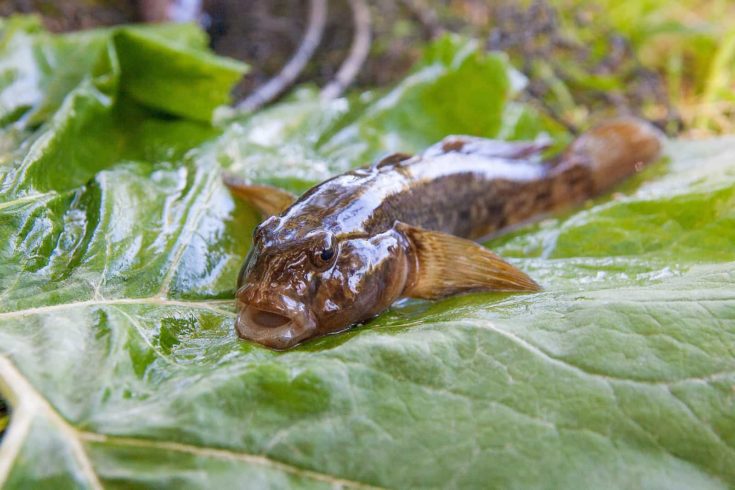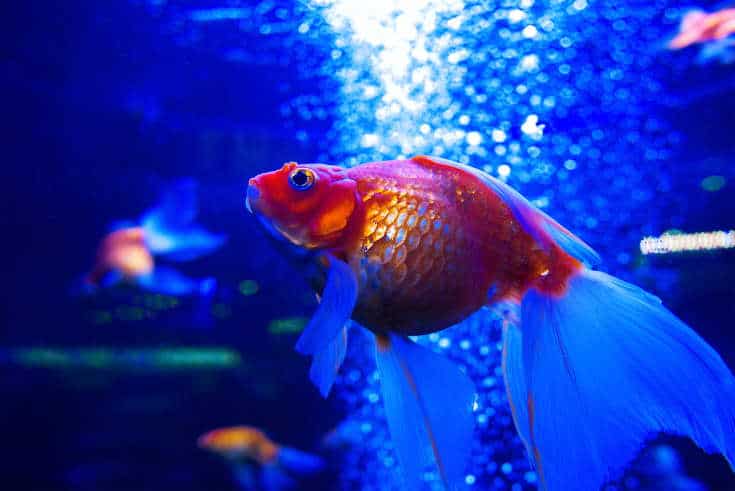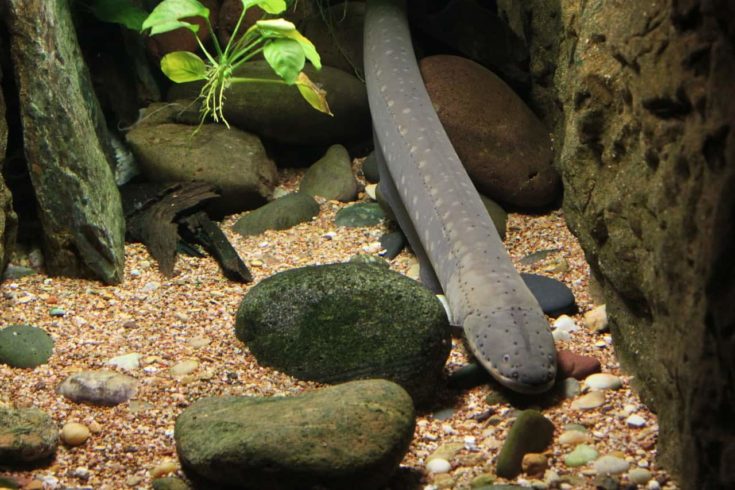How Long Can Goldfish Live Out Of Water
Have you heard the expression, "similar a fish out of water?" That sometime maxim refers to someone who is uncomfortable in a item situation.
If you lot always had a fish jump out of its tank, you'll have seen it flapping effectually on your floor, conspicuously desperate to find h2o. That's where the expression comes from. Now, apparently, you'll need to get your pet back into his aquarium as soon as possible. But how long can a fish live out of water?
Keep reading to find out!
Tin Fish Survive Out Of Water?

Most don't take the physiology that's necessary for them to take oxygen directly from atmospheric air. And so, how long tin can your pet or tropical fishes survive out of their tank?
Generally, fish species, such as Neon tetras, guppies, and Rainbow sharks, can simply survive for a maximum of ten minutes when out of water. The stress and shock of being out of their natural surround and the inability to breathe frequently reduces survival time to simply a few minutes.
Virtually freshwater fish don't last as long out of the water as saltwater species. That's because freshwater pets are typically more delicate and sensitive than their marine cousins.
What Happens To A Pet Fish Out Of H2o?
Removing a fish from its natural watery environment is extremely stressful for the brute. The fish has no access to usable oxygen and quickly begins to gasp for air, ultimately suffocating within a few minutes. The fish volition oftentimes flap its fins as it attempts to move and notice water. The fish's gills and so open and arch until information technology collapses and death occurs within a very short menses of time.
Take Precautions!
So, be extremely careful when moving or transporting your fish. If you're moving firm or bringing new one abode from the store, always place the fish in their bag of h2o in a leak-proof container, just in example the bag splits.
When cleaning out your tank or carrying out routine maintenance tasks, take care not to alarm the fish so that they panic and jump out of the water. Also, when introducing new fish to an established community setup, watch the fish very advisedly for signs of bullying that might cause escape attempts.
Some species, such as bettas, are achieved jumpers. So, always go along acrobatic fish in a tank that has a embrace slide or tightly fitting lid.
How Do Fish Breathe Underwater?
Just similar you lot and me, fish need to absorb oxygen and expel carbon dioxide to live. Withal, instead of lungs similar mammals, most have gills.
Gills are branched structures that comprise complex networks of tiny blood vessels called capillaries. Each time the fish opens its mouth, water flows across the gills. The blood in the capillaries extracts dissolved oxygen from the water and circulates that around the fish'south torso to its vital organs and body tissues. If y'all observe your fish breathing very rapidly, that's a sign that there's not plenty oxygen in the h2o.
Bony species accept another physiological structure called the operculum. The operculum is a bony plate that opens and closes as the fish "breathes," protecting the sensitive gills. If you go on shrimp and snails, y'all'll be interested to know that they also have gills.
Crustaceans and mollusks' gills work in the same way as your fish's, extracting oxygen from the h2o every bit information technology flows over the gills. Marine creatures, such as sea slugs or nudibranchs, have external feathery gills that protrude every bit brightly-colored structures from the animal's back.
Animate Underwater
The atmospheric air that yous and I breathe contains around 200,000 parts per million (ppm) of concentrated oxygen. Compare that with water that has a concentration of only 4 to 8 ppm. Equally you can imagine, that means a lot of water must laissez passer over the fish's gills for the beast to get all the oxygen it needs. Fortunately, the gills are incredibly efficient at extracting oxygen!
"Expressionless Zones"
In a natural habitat where oxygen is in short supply, breathing is even more challenging for the fish. In the aquarium, hypoxic "dead zones" sometimes form in areas where the substrate becomes compacted, and h2o circulation is poor. In these pockets, oxygen levels are extremely depression, and the h2o is often brackish, harboring colonies of toxic bacteria. Too many dead zones in the aquarium can return the surround uninhabitable and devoid of oxygen, resulting in mass kills.
However, if yous keep up to speed with your aquarium maintenance and cleaning tasks, including vacuuming the substrate, you can prevent dead zones from forming and threatening your fish.
In the wild environment, human action tin can crusade hypoxic zones to form, causing a catastrophic drib in the oxygen level. Recently, in 2019, farm run-off caused a huge dead zone to form in the Gulf of United mexican states, killing thousands and putting other wildlife at risk, likewise.
Why Do Survival Rates Vary?
So, how come some species can survive out of water for longer than others?
At that place are several factors that directly affect the survival rates out of water.
Type of Fish
Some can survive for longer than others if they end up out of the water.
For example, amphibious fish can often live for hours, days, or even years without existence in the water, thanks to evolutionary physiological quirks that enable them to withstand farthermost weather condition.
Metabolic Rate
Usually, fish that live in warm climates take a faster metabolic charge per unit than those from cooler regions. The faster the fauna's metabolic charge per unit, the more oxygen it needs to survive. So, fish that live in colder temperatures can theoretically survive out of the water for longer.
Oxygen Demands
Some aquarium fish have higher oxygen demands than others.

For example, goldfish are very oxygen-hungry, and then they need a tank with enough of area for good gaseous exchange and a filtration unit that generates a high flow. And then, if your goldfish jumped out of your tank or pond and ended upwards on the carpet or decking, he well-nigh likely wouldn't final very long.
That said, one of my goldfish was fished out of the garden pond past my cat. The fish flapped around for quite a few minutes before I managed to scoop it upwards and get it back into the water, miraculously none the worse for its adventure.
Why Do Fish Get out The Water?
But why do fish leave their natural aquatic habitat in the first identify?
In that location are a few reasons why some species feel the need to get out the water:
- To avoid predators
- To escape polluted or oxygen-depleted water
- To escape water that's too warm
- To detect food or mates
- To escape a irresolute environment where the water is drying up
Now, let's take a look at some of the species that can actually breathe air and even survive out of the water.
What Fish Species Can Exhale Out Of Water?
In that location are quite a few species that tin manage just fine when out of the water for a short fourth dimension. Who knew?!
Betta Fish

Betta and other members of the gourami family are commonly referred to as labyrinth breathers or Anabantoidei.
These have a specially adjusted organ within the body cavity called the labyrinth organ. The labyrinth organ contains lots of small compartments composed of sparse bony plates or lamellae. The lamellae are encased in fine, permeable membranous tissue that allows oxygen to exist absorbed. The membranes incorporate super-fine capillaries that carry the oxygen in the claret around the torso in the fish's bloodstream.
During the dry out season, when the small ponds and streams in which they live brainstorm to dry out upward, betta fish tin can bound from one body of water to another. As long every bit the fish remains moist, it tin can survive for quite a while, thanks to the labyrinth organ. In the aquarium, you'll oftentimes come across labyrinth species visiting the water surface to take gulps of air to supplement the dissolved oxygen that they derive from the water.
Dolphins And Whales
Although they don't possess a labyrinth organ, certain ocean-going fish can breathe atmospheric air.
Okay, so the creatures we're referring to here are actually not fish at all, only mammals like you and me. However, these animals, including dolphins and whales, are sometimes mistaken for fish since they spend their whole lives in the water.
These bounding main-dwellers have lungs, significant that they need to make frequent trips to the water surface to breathe via their blowhole. Once the brute has taken a jiff, the blowhole closes so that water doesn't enter the lungs when the creature is submerged. Every bit the whale or dolphin surfaces to breathe, the blowhole opens and the animal blows to clear water from the blowhole, creating the spectacular spout you'll take seen if you've ever been whale watching.
Why Don't Whales Suffocate?
Did you know that Blue whales can remain underwater for over an hour without needing to have a breath!
Well, yous breathe on average 12 to xx times every infinitesimal while you're just chilling out, but you just absorb around 5% of the oxygen from each breath. Whales, on the other hand, can absorb up to 90% of the oxygen from every breath they take. And then, a whale takes in a whole lot more oxygen in each breath than you lot exercise, pregnant that the creature doesn't demand to breathe so frequently.
Also, whales' lungs tin can shop oxygen in a poly peptide called myoglobin that'southward found in the muscles. While underwater, whales can slow their heart rate and restrict the blood supply to a few key organs, further reducing the amount of oxygen they need.
So, that's how whales are able to stay submerged for and so long.
Mangrove Killifish
The Mangrove Killifish is as well known as the Mangrove rivulus and is found in parts of the Atlantic and the Caribbean. The fish lives in marine, brackish, and sometimes freshwater habitats, peculiarly mangrove forests and estuarine waters.
These foreign fish are amphibious, sometimes living on the state for upwardly to 2 months and arresting the oxygen they demand through their peel.
Mudskippers
Mudskippers are also amphibious fish that happily spend much of their lives out of water. In fact, the fish are so well-adjusted for life on terra firma that they have developed specially positioned pectoral fins that work similar legs, enabling them to propel themselves beyond mudflats. Amazingly, these fish tin can jump over two feet, as well as climbing trees, using their fins for propulsion.
The mudskipper's skin contains blood vessels that can extract oxygen from the air, effectively enabling the fish to breathe right through its skin.
Walking Catfish
The Walking catfish from Southeast Asia is a large creature that can grow upwardly to twenty inches in length. Similar the Mudskipper, Walking catfish (Clarias batrachus) can use their pectoral fins to propel them beyond dry land in search of water during the dry flavour.
Every bit well equally gills, the Walking catfish has a set of air-breathing organs that simply come up into play when the fish is out of water, enabling the creature to breathe atmospheric air.
Rockskipper Fish
The Rockskipper is also known as the Coral blenny (Istiblennius zebra).
These Hawaiian freshwater fish live in exposed habitats where they live in shallow pools. To get in search of nutrient, new territories, or mates, the Rockskipper literally skips or jumps from puddle to pool.
These curious little fish are able to breathe air via reinforced cutaneous gill rods behind their gills.
Snakehead Fish
Snakeheads are common in parts of Asia and Africa. These fish are amphibious carnivores that can get out the water to hunt for prey on land. Some species of Snakehead fish tin alive on land for upward to half dozen days, moving across the land in search of new habitat.
Lungfish
Lungfishes are ancient creatures that inhabit freshwater habitats in Africa, Commonwealth of australia, and South America, depending on the species.
These descendants of the Osteichthyes are one of only a few species of fish that take the ability to exhale on land and in water, possessing both lungs and gills. When the fish's watery dwelling dries up during droughts, the fish can enter a dormant state, breathing solely through their lungs and surviving for up to four years until they can observe water again.
Eels

Eels are relatively mutual freshwater ray-finned fish that tin negotiate obstacles while swimming upriver to spawn. The fish can derive oxygen from the air directly through their pare, enabling them to make arduous journeys from the bounding main to their freshwater river breeding grounds.
Climbing Perch
The Climbing Perch (Anabas testudineus) is constitute in India and China. These fish belong to the same family as gouramis, and are able to breathe out of the water, surviving for up to ten hours, as long as they remain moist.
These are popular as a food source in their native lands, largely considering the fish can exist kept fresh for a long time in a very small-scale amount of h2o.
In Decision
Did y'all notice our guide to how long a fish can live out of water helpful? If you lot did, please share. Also, feel costless to comment in the comments box below.
If you keep tropical or marine fish, be very careful that your pets don't jump out of your aquarium when your back is turned! Pet fish can but survive for a few minutes in one case out of water. Even labyrinth fish must remain moist to survive, and that won't happen on your living room carpet!
How Long Can Goldfish Live Out Of Water,
Source: https://www.tankarium.com/how-long-can-a-fish-live-out-of-water/
Posted by: donaldsonmucland.blogspot.com


0 Response to "How Long Can Goldfish Live Out Of Water"
Post a Comment